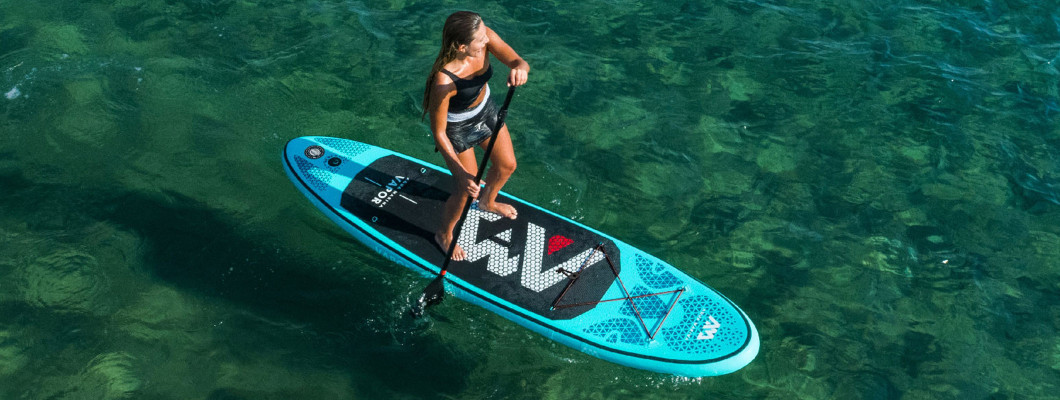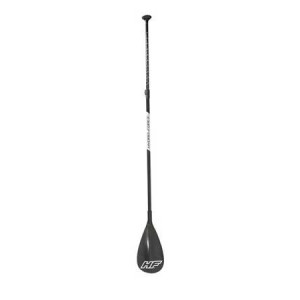What is Stand Up Paddleboarding (SUP)?

SUP is a type of water sport in which you stand on a specialized SUP board and move with a canoe paddle in open waters. This is an exciting way to enjoy the beauty of nature while rowing. The sport is suitable for people of all ages. Some forms of SUP boards simply require more practice.
What are the different types of SUP boards and their use?

Universal (All-around) SUP boards
All-around boards are the most versatile and most common. They are suitable for calm open waters or open waters with slight excitement. All-around boards are a good choice for beginner rowers.
- Medium length 304 - 380 cm.
- Medium width 76 - 86 cm
SUP boards for fishing - They are a combination of a SUP board and a boat

SUP boards for calm waters (flat-water)
FLATWATER / TOURING SUP boards are usually longer, narrower and usually with a slightly pointed nose compared to all other SUP boards, so that they can travel longer distances more smoothly and faster, while having less problems maintaining a straight line.
- Medium length 335 - 426 cm.
- Medium width 71 - 81 cm
SUP boards for stormy open waters (ocean)
OPEN OCEAN SUP boards are similar to those for calm and quiet waters. The only difference is that they are more turned in the nose to cope better with the waves, such a nose will slow you down more in calm water.
- Medium length 335 - 426 cm
- Medium width 71 - 81 cm
SUP boards for racing
RACING SUP boards are usually longer, narrower and have a pointed nose compared to other SUP boards. RACING SUP boards are suitable for competitions where it is necessary to develop speed. There are two categories of SUP boards for competitions. Some are for sprint competitions and their length is 381 cm. The others are for long distance competitions and their length is 426 cm. The average width is 63 - 73 cm.

Surfing SUP boards
SURFING SUP boards are shorter than all SUP boards, they are narrower. The narrower the board, the more effort it will take to balance it.
- Medium length 213 - 317 cm
- Medium width 68 - 81 cm
SUP boards for fitness / yoga
Fitness / yoga SUP boards are wider, bigger and more stable. They have no accessories other than the obligatory paddle.

What kind of paddle do I need?
The paddle is made of 3 parts:
Handle - A "T" -shaped handles is common.
Shoulder - made of different materials:
- Carbon - hard, resistant to mechanical damage and light enough.
- Fiberglass - lighter, flexible and ensures smoother movements.
- Aluminum - a hard material, but heavy.
- Kevlar - high impact of resistance, similar to Carbon.
Rowing shovel - can vary in shape and size.
Some oars are adjustable in height, but in general:
- Surf SUP paddles are usually between 15-20 cm above the height of the rowers, due to the lower position when surfing.
- For calm waters, SUP paddles are between 20-25 cm above the height of the paddlers. This type of SUP paddles allows more powerful paddling.
- Racing SUP paddles are 25-30 cm high above the height of the rowers. This allows a higher speed to develop.

What type of SUP board is right for me?
General rule:
- The wider the board, the more stable it is (rowing, fishing).
- The narrower the board, the faster it is (competitions, surfing).
- The longer the board, the greater the speed it can develop (racing, rowing in open water).
- The shorter the board, the better maneuverability you will get (surfing).
Store your SUP board in a shady and ventilated place.
Be careful where you place the board in the water, there may be rocks or other sharp objects under it that can damage the board.
Be careful when rowing and avoid obstacles that could damage the board, paddle or fin.
Wash your SUP equipment after being in salt water.
Do not drag your SUP board - when you take your board in or out of the water, do not allow it to drag on rocks, debris or even sand.
Check for holes regularly - the sooner you catch them, the sooner you will be able to deal with them.

